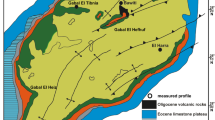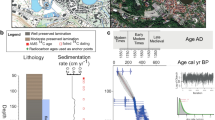Abstract
The mid-late Campanian Dinosaur Park Formation outcropping within Dinosaur Provincial Park, Alberta, Canada, contains multiple dinosaur deposits occurring as bone beds, articulated skeletons, isolated bones and microvertebrate deposits. Due to the abundance of dinosaur deposits, the exposure of Cretaceous sediments, and the presence of charcoal, this locality acts as a good test site for investigating the implications of fire-impacted landscapes for the formation of vertebrate deposits. Despite prior palaeontological and geological research being carried out into this Formation, the presence of charcoal in vertebrate deposits has never previously been recorded. This study compares charcoal content in vertebrate deposits (two bone beds, two beds with articulated skeletons), 6 sediment samples with isolated bones and 23 sediments with no bone. Charcoal is more abundant in the vertebrate deposits than in sediments containing isolated bones or no bones, including those in identical lithofacies. This evidence suggests that flooding events following wildfires are likely to have played a role in the formation of some vertebrate deposits.








Similar content being viewed by others
References
Abu Hamad AMB, Jasper A, Uhl D (2012) The record of Triassic charcoal and other evidence for palaeowildfires: signal for atmospheric oxygen levels, taphonomic biases or lack of fuel. Int J Coal Geol 96–97:60–71
Belcher CM, Mander L, Rein G, Jervis FX, Haworth M, Hesselbo SP, Glasspool IJ, McElwain JC (2010) Increased fire activity at the Triassic/Jurassic boundary in Greenland due to climate-driven floral change. Nat Geosci 3:426–429
Brown SAE, Scott AC, Glasspool IJ, Collinson ME (2012) Cretaceous wildfires and their impact on the Earth system. Cretac Res 36:162–190
Cannon SH, Reneau SL (2000) Conditions for generation of fire-related debris flows, Capulin Canyon, New Mexico. Earth Surface Processes and Landforms 25:1103–1121
Currie PJ, Dodson P (1984) Mass death of a herd of Ceratopsian dinosaurs. In: Reif WE, Westphal F (eds) Third symposium on Mesozoic terrestrial ecosystems, short papers. Attempto Verlag, Tübingen, Germany, pp 52–60
Currie PJ, Koppelhus EB (eds) (2005) Dinosaur Provincial Park: a spectacular ancient ecosystem revealed. Indiana University Press, Bloomington
Eberth DA (2005) The Geology. In: Currie PJ, Koppelhus EB (eds) Dinosaur Provincial Park: a spectacular ancient ecosystem revealed. Indiana University Press, Bloomington, pp 54–82
Eberth DA, Brinkman DB, Barkas V (2010) A Centrosaurine mega-bonebed from the Upper Cretaceous of southern Alberta: Implications for behaviour and death events. In: Ryan MJ, Chinnery-Allgeier BJ, Eberth DA (eds) New Perspectives on Horned Dinosaurs. Indiana University Press, Bloomington, pp 495–508
Eberth DA, Currie PJ (2005) Vertebrate taphonomy and taphonomic modes. In: Currie PJ, Koppelhus EB (eds) Dinosaur Provincial Park: a spectacular ancient ecosystem revealed. Indiana University Press, Bloomington, pp 453–477
Eberth DA, Evans DC (2011) Hadrosaur Symposium Guidebook: Geology and palaeontology of Dinosaur Provincial Park, Alberta. Special publication of the Royal Tyrrell Museum, Alberta
Eberth DA, Getty MA (2005) Ceratopsian bone beds: occurrence, origins and significance. In: Currie PJ, Koppelhus EB (eds) Dinosaur Provincial Park: a spectacular ancient ecosystem revealed. Indiana University Press, Bloomington, pp 501–536
Ekpo BO, Ibok UJ, Essien N, Wehner H (2012) Geochemistry and organic petrography of Cretaceous sediments of the Calabor Flank, Southeastern Nigeria. Mar Pet Geol 35:252–268
Glasspool IJ, Edwards D, Axe L (2004) Charcoal in the Silurian as evidence for the earliest wildfire. Geology 32:381–383
Glasspool IJ, Scott AC (2010) Phanerozoic atmospheric oxygen concentrations reconstructed from sedimentary charcoal. Nat Geosci 3:627–630
Goode JR, Luce CH, Buffington JM (2012) Enhanced sediment delivery in a changing climate in semi-arid mountain basins: Implications for water resource management and aquatic habitat in the northern Rocky Mountains. Geomorphology 139–140:1–15
Hudspith V, Scott AC, Collinson ME, Pronina N, Beeley T (2012) Evaluating the extent to which wildfire history can be interpreted from inertinite distribution in coal pillars: An example from the Late Permian, Kuznetsk Basin, Russia. Int J Coal Geol 89:13–25
Jenkins SE, Hull SC, Anderson DE, Kaufman DS, Pearthree PA (2011) Late Holocene geomorphic record of fire in ponderosa pine and mixed-conifer forests, Kendrick Mountain, northern Arizona, USA. Int J Wildland Fire 20:125–141
Jones TP (1993) New morphological and chemical evidence for a wildfire origin for fusain from comparisons with modern charcoal. Spec Pap Palaeontol 49:113–123
Kent M, Coker P (1992) Vegetation description and analysis. Belhaven Press, London
Lovelace DM (2006) An upper Jurassic Morrison formation fire-induced debris flow: taphonomy and paleoenvironment of a Sauropod (Sauropoda: Supersaurus vivianae) locality, east- central Wyoming. In: Foster JR, Lucas SG (eds) Paleontology and Geology of the Upper Jurassic Morrison Formation, vol 36, New Mexico Museum of Natural History and Science Bulletin, pp 47–65
Mallon JC, Evans DC, Ryan MJ, Anderson JS (2012) Megaherbivorous dinosaur turnover in the Dinosaur Park Formation (upper Campanian) of Alberta, Canada. Palaeogeogr Palaeoclimatol Palaeoecol 350–352:124–138
Meyer GA, Wells SG (1997) Fire-related sedimentation events on alluvial fans. Yellowstone National Park, USA J Sediment Res 67:776–791
Meyer GA, Wells SG, Balling RC, Jull AJT (1992) Response of alluvial systems to fire and climate change in Yellowstone National Park. Nature 357:147–150
Moody JA, Martin DA (2009) Forest fire effects on geomorphic processes. In: Cerdá A, Robichaud P (eds) Fire effects on soils and restoration strategies. Science Publishers, Enfield, NH, pp 41–79
Moody JA, Martin DA, Cannon SH (2008) Post-wildfire erosion response in two geologic terrains in the western USA. Geomorphology 95:103–118
Pierson TC (2005a) Distinguishing between debris flows and floods from field evidence in small watersheds U.S. Geological Survey Fact Sheet 2004–3142:4
Pierson TC (2005b) Hyperconcentrated flow - transitional process between water flow and debris flow. In: Jacob M, Hungr O (eds) Debris-flow hazards and related phenomena. Springer, Berlin, pp 159–202
Petersen HI, Lindström S (2012) Synchronous wildfire activity rise and mire deforestation at the Triassic- Jurassic boundary. Plos ONE 7:1–15
Ryan MJ, Evans DC (2005) Ornithischian Dinosaurs. In: Currie PJ, Koppelhus EB (eds) Dinosaur Provincial Park: a spectacular ancient ecosystem revealed. Indiana University Press, Bloomington, pp 312–348
Ryan MJ, Russell AP, Eberth DA, Currie PJ (2001) The taphonomy of a Centrosaurus (Ornithischia: Certopsidae) bone bed from the Dinosaur Park Formation (Upper Campanian), Alberta, Canada, with comments on cranial ontogeny. Palaios 16:482–506
Sander PM (1987) Taphonomy of the Lower Permian Geraldine bonebed in Archer County, Texas. Palaeogeogr Palaeoclimatol Palaeoecol 61:221–236
Scott AC (2000) The pre-Quaternary history of fire. Palaeogeogr Palaeoclimatol Palaeoecol 164:281–329
Scott AC (2010) Charcoal recognition, taphonomy and uses in palaeoenvironmental analysis. Palaeogeogr Palaeoclimatol Palaeoecol 291:11–39
Scott AC, Jones TJ (1994) The nature and influence of fires in Carboniferous ecosystems. Palaeogeogr Palaeoclimatol Palaeoecol 106:91–112
Shakesby RA, Doerr SH (2006) Wildfire as a hydrological and geomorphological agent. Earth Sci Rev 74:269–307
Sweetman SC, Insole AN (2010) The plant debris beds of the Early Cretaceous (Barremian) Wessex Formation of the Isle of Wight, southern England: their genesis and palaeontological significance. Palaeogeogr Palaeoclimatol Palaeoecol 292:409–424
Varnes DJ, the IAGE Commission on landslide and other mass movements on slopes (1984) Landslide hazard zonation: A review of the principles and practice. UNESCO, Paris
Wohl EE, Pearthree PA (1991) Debris flows as geomorphic agents in the Huachuca Mountains of southeastern Arizona. Geomorphology 4:273–292
Wolfe SA, Ollerhead J, Huntley D, Lian OB (2006) Holocene dune activity and environmental change in the prairie parkland and boreal forest, central Saskatchwan, Canada. Holocene 16:17–29
Zeigler KE, Heckert AB, Lucas SG (2005) Taphonomic analysis of a fire-related Upper Triassic vertebrate fossil assemblage from North-Central New Mexico. In: Geology of the Chama basin, 56th Field Conference Guidebook. New Mexico Geological Society, Socorro, pp. 341–354
Acknowledgements
We thank Dennis Braman for assistance with fieldwork and for his generous hospitality whilst S.A.E.B. worked in Canada. We thank the Canadian Park Authority for access to Dinosaur Provincial Park and the Royal Tyrrell Museum of Palaeontology for logistic support during field-work. We are extremely grateful to Dennis Braman and D. Eberth for helpful comments on an earlier manuscript. S.A.E.B. thanks the Department of Earth Sciences Research Committee of Royal Holloway University of London for a grant to undertake laboratory work. We thank Sharon Gibbons for technical support with the processing of a single sample that required HF treatment. We are very grateful to our reviewers, Dieter Uhl and Deborah Martin, for their helpful comments and suggestions that have greatly improved the manuscript.
Author information
Authors and Affiliations
Corresponding author
Rights and permissions
About this article
Cite this article
Brown, S.A.E., Collinson, M.E. & Scott, A.C. Did fire play a role in formation of dinosaur-rich deposits? An example from the Late Cretaceous of Canada. Palaeobio Palaeoenv 93, 317–326 (2013). https://doi.org/10.1007/s12549-013-0123-y
Received:
Revised:
Accepted:
Published:
Issue Date:
DOI: https://doi.org/10.1007/s12549-013-0123-y




